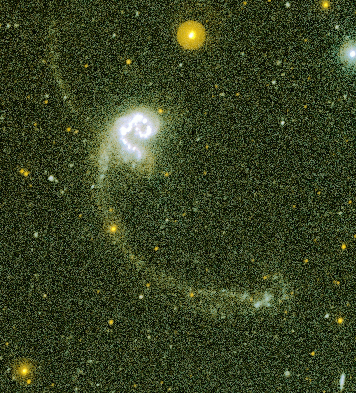
UV Morphology and Star Formation in the Tidal Tails of
NGC 4038/9
J.E. Hibbard (NRAO),
L. Bianchi (JHU),
D. Thilker (JHU),
R. M. Rich (UCLA),
D. Schiminovich (Columbia, Caltech),
C.K. Xu (Caltech),
S. Neff (Goddard),
M. Seibert (Caltech),
S. Lauger (Marseille),
D. Burgarella (Marseille),
T.A. Barlow (Caltech),
Y-I. Byun (Yonsei),
J. Donas (Marseille),
K. Forster (Caltech),
P.G. Friedman (Caltech),
T.M. Heckman (JHU),
P.N. Jelinsky (Berkeley),
Y-W. Lee (Yonsei),
B.F. Madore (OCIW),
R.F. Malina (Marseille),
D.C. Martin (Caltech),
B. Milliard (Marseille),
P. Morrissey (Caltech),
O.H.W. Siegmund (Berkeley),
T. Small (Caltech),
A.S. Szalay (JHU),
B.Y. Welsh (Berkeley), and
T.K. Wyder (Caltech)
The Astrophysical Journal Letters, 619, L87 (2005)
(pdf 317 kB)
(ADS)
(astro-ph/0411352)
We present GALEX FUV (1530 A) and NUV (2310) observations of the
archetypal merging system NGC 4038/39, ``The Antennae". Both tails are
relatively bright in the UV, especially in the vicinity of the
Tidal Dwarf Galaxy candidates at the end of the southern tail. The UV
light generally falls within the optically delineated tails, although
the UV light is considerably more structured, with a remarkably
similar morphology to the tidal HI. The UV colors suggest that there
has been continuing star formation within the tidal tails, even outside
the previously studied Tidal Dwarf region. Within the inner
disk regions, there are interesting UV features which appear to be
related to the extended soft X-ray loops and halo recently discovered
by Chandra.
Image to left: false color FUV (blue), FUV+NUV (green), NUV (red)
GALEX image of NGC 4038/39.
Go here for more figures on NGC 4038/9
Paper and Figures:
Additional Figures:
- eps.gz of two options for fig2a,b:
top=full res FUV (B),FUV+NUV (G),NUV (R) w/HI contours; bottom=low-res
FUV (B), full res FUV+NUV (G), low-res NUV (R) w/HI contours.
- Q.gif contours of Sigma_gas/Sigma_crit (=1.5, 3, 4.5), on FUV-NUV and FUV
- Plots of UV surface brightness vs. HI column density.
Red: (FUV-NUV)>1; GREEN: 1>(FUV-NUV)>0; BLUE: (FUV-NUV)<0.
crosses=disk; triangles=TDG; diamonds=Ntail; stars=Stail:
Linear;
Log.
- color.gif FUV-NUV, FUV-B, NUV-B.
- ann.gif Galex greys with objects
identified in Saviane et al. 2004
plotted as follows: upper left=stellar associations;
upper right: add bright blue stars (t<30 Myr); lower right:
add bright red stars (t~80-100 Myr); lower left=add faint
blue stars. Compare this with
Fig 9 of Saviane et al. 2004
- eps.gz of original 12-panel fig1 (1.1 MB)
- Poster presented at 205th AAS, Jan 9-13
2005, San Diego (1MB)
Last modified: Thu Aug 11 16:14:45 EDT 2005
Back to home
Maintained by
jhibbard
@ nrao.edu
